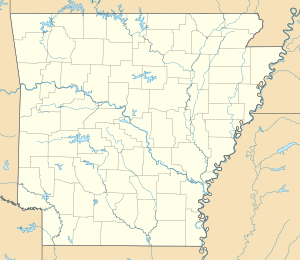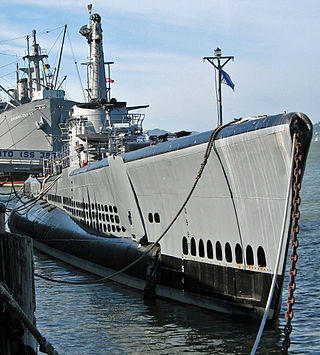
USS Pampanito (SS-383/AGSS-383), a Balao-class submarine, is a United States Navy ship, the third named for the pompano fish. She completed six war patrols from 1944 to 1945 and served as a United States Naval Reserve training ship from 1960 to 1971. She is now a National Historic Landmark, preserved as a memorial and museum ship in the San Francisco Maritime National Park Association located at Fisherman's Wharf in San Francisco, California.

USS Robalo (SS-273), a Gato-class submarine, was the only ship of the United States Navy to be named for the róbalo or common snook.

The Balao class was a design of United States Navy submarine used during World War II, and with 120 boats completed, the largest class of submarines in the United States Navy. An improvement on the earlier Gato class, the boats had slight internal differences. The most significant improvement was the use of thicker, higher yield strength steel in the pressure hull skins and frames, which increased their test depth to 400 feet (120 m). Tang actually achieved a depth of 612 ft (187 m) during a test dive, and exceeded that test depth when taking on water in the forward torpedo room while evading a destroyer.

USS Snook (SS-279), a Gato-class submarine, was the first ship of the United States Navy to be named for the common snook, an Atlantic marine fish that is bluish-gray above and silvery below a black lateral line.
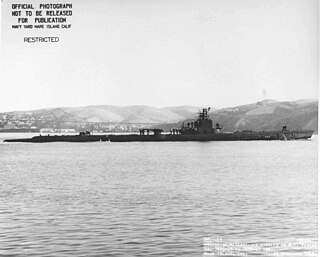
USS Gar (SS-206) was the first of the Gar subclass of the Tambor-class submarines to be commissioned for the United States Navy just prior to the country's 7 December 1941 entry into World War II. These submarines were a slightly improved version of preceding submarines of the Tambor class. While Gar survived the war, all of her sister ships — USS Grampus (SS-207), 'USS Grayback (SS-208), USS Grayling (SS-209), USS Grenadier (SS-210), and USS Gudgeon (SS-211) — were lost. She is the only ship of the United States Navy to be named for the gar, a fish of the family Lepisosteidae.

USS Bergall (SS-320), a Balao-class submarine in commission from 1944 to 1958, was the first ship of the United States Navy to be named for the bergall, a small fish of the New England coast. During World War II she made five war patrols between 8 September 1944 and 17 June 1945, operating in the South China Sea, Java Sea, and Lombok Strait and north of the Malay Barrier. During these patrols she sank two Japanese merchant ships totaling 14,710 gross register tons and one 740-displacement ton Imperial Japanese Navy frigate. She also damaged the Japanese heavy cruiser Myōkō, which was never repaired.

USS Scabbardfish (SS-397), a Balao-class submarine, was the only ship of the United States Navy to be named for the scabbarddfish, a long, compressed, silver-colored fish found on European coasts and around New Zealand. In 1965 she was transferred to the Hellenic Navy and renamed Triaina.

USS Raton (SS/SSR/AGSS-270), a Gato-class submarine, was a ship of the United States Navy named for the raton, a polynemoid fish inhabiting semitropical waters off the Pacific coast of the Americas.
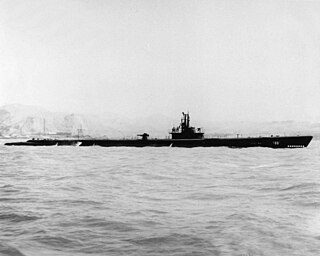
The first USS Trepang (SS/AGSS-412) was a Balao-class submarine in the United States Navy. She was named after the trepang, an Indonesian name for a marine animal called a "sea slug" or a "sea cucumber," having a long, tough, muscular body and found in the coral reefs of the East Indies.

The first USS Batfish (SS/AGSS-310) is a Balao-class submarine, known primarily for the remarkable feat of sinking three Imperial Japanese Navy submarines in a 76-hour period, in February 1945. USS Batfish is the first vessel of the United States Navy to be named for the batfish, a type of anglerfish that crawls about on the sea floor.

USS Becuna (SS/AGSS-319), a Balao-class submarine in commission from 1944 to 1969, was a submarine of the United States Navy named for the becuna, a pike-like fish of Europe. During World War II, she conducted five war patrols between August 23, 1944 and July 27, 1945, operating in the Philippine Islands, South China Sea, and Java Sea. She is credited with sinking two Japanese tankers totaling 3,888 gross register tons.

USS Blackfin (SS-322), a Balao-class submarine in commission from 1944 to 1948 and from 1951 to 1972, was a ship of the United States Navy named for the blackfin cisco, a food fish of the Great Lakes.

USS Bumper (SS-333), a Balao-class submarine, was a ship of the United States Navy named for the bumper, a small fish of the North and South Atlantic Ocean.

USS Sea Cat (SS/AGSS-399), a Balao-class submarine, was a ship of the United States Navy named for a shortened form of sea catfish, a marine fish of little food value found off the southeastern coast of the United States commissioned on 16 May 1944, with Commander Rob Roy McGregor in command. During World War II Sea Cat operated within the Pacific theatre, conducting four war patrols in wolf packs accounting for up to 17400 tons in the form of three cargo ships and an enemy vessel. Sea Cat earned three battle stars for her World War II service.

USS Sennet (SS-408) was a Balao-class submarine, a ship of the United States Navy named for the sennet, a barracuda.
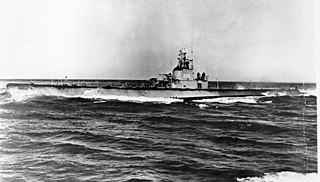
USS Cobia (SS/AGSS-245) is a Gato-class submarine, formerly of the United States Navy, named for the cobia.

Hoga (YT-146/YTB-146/YTM-146) is a United States Navy Woban-class district harbor tug named after the Sioux Indian word for "fish." After World War II, the tug was known as Port of Oakland and then City of Oakland when she was a fireboat in Oakland, California.
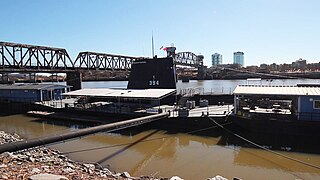
The Arkansas Inland Maritime Museum is a maritime museum located at 120 Riverfront Park Drive, North Little Rock, Arkansas which opened on May 15, 2005. The museum's collection includes artifacts from multiple vessels from the state's history, as well as two World War 2 vessels.

